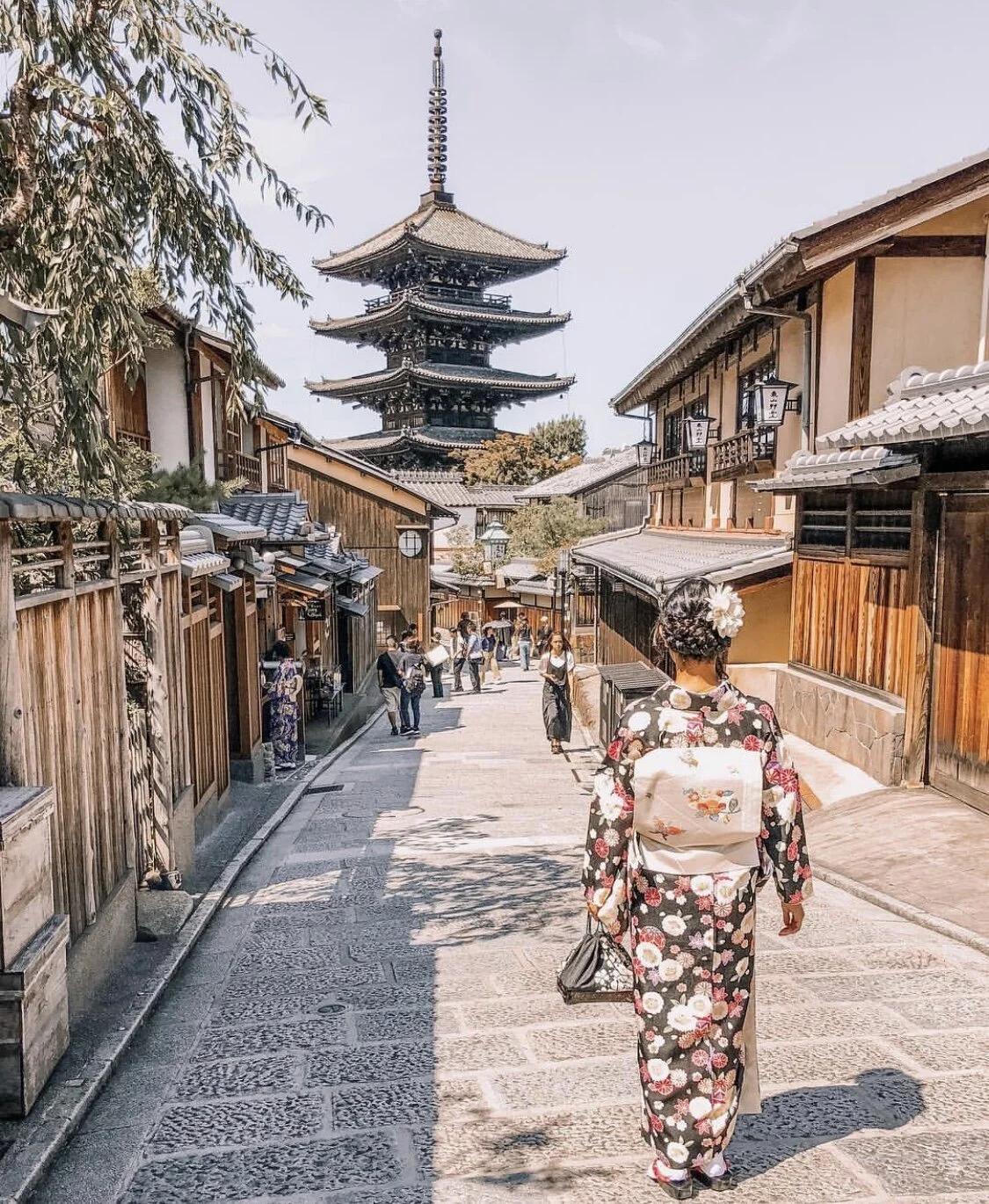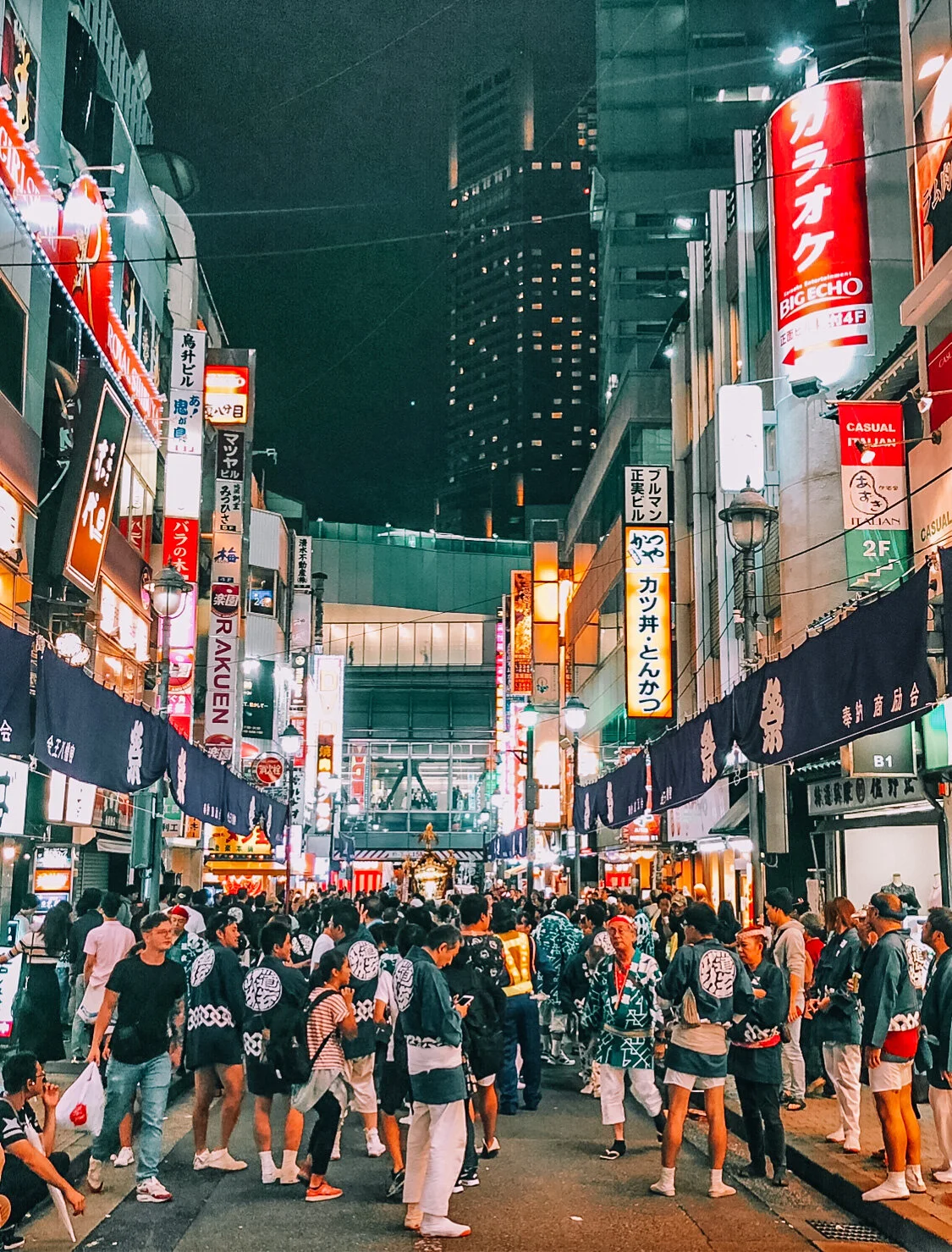Kyoto, Japan
An absolute gem. This city seeps history and tradition of the Japanese people. I recommend renting a kimono or yukata for a day in this city. Unfortunately, because of the high tourism this city receives, it does slightly take away from the authentic feel one might anticipate feeling here. But don’t let that take away from your impression of the city itself—Kyoto is unlike any other place!
Things to Do
Fushimi Inari Taisha shrine
One of the most iconic shrines in Japan known for it’s thousands of torii gates.
“Take a moment to stop by the Omokaru Stones near the entrance.
The 2 stone lanterns are each topped with a heavy ornament called a giboshi. Make a wish and try to lift one of the giboshi.
If a stone is lighter than expected → it’s said your wish will be granted.
If a stone is heavy, you may face hardship and trials in reaching your goal. “ —-https://theculturetrip.com/asia/japan/articles/the-top-10-things-to-do-and-see-in-kyoto/
10,000 gates of Fushimi Inari – if you can, hike all the way to the summit of Mt. Inari.
Takes about an hour to hike to the top
Hours: always open.
Admission: free
68 Fukakusa Yabunouchi-cho, Fushimi-ku, Kyoto City, Kyoto Prefecture, Japan
Fushimi Inari Taisha Shrine
Yokai Street — discover Japanese ghosts and goblins
“Kyoto, Japan’s Ichijo-dori street is a fairly typical neighborhood street save for the dozens of monsters standing sentinel in front of most of the local businesses….Despite what it might seem like, the street is not a typical tourist grab. It is populated by small local businesses catering to clientele in the neighborhood. There are not souvenir shops or anything of the sort, simply fun, quirky attempts to bring some attention to the neighborhood and breathe some life into aspects of all but forgotten Japanese folklore.” — https://www.atlasobscura.com/places/yokai-street
Japan’s native Shinto religion is based on nature worship and animism.
Taishogun Shotengai Ohigashi-cho, Kamigyo Ward, Kyoto City, Kyoto Prefecture,, Japan
Kitchi-Kichi — eat the most famous omurice in Japan
Omelet rice —> fluffy omelet on a mound of rice pilaf
Yukimuri Motokichi’s signature cooking technique
Mon – Sun: 5 pm to 9 pm
185-4 Zaimokucho, Nakagyo-ku, Kyoto City, Kyoto Prefecture, Japan
Uji City — harvest your own green tea then enjoy a freshly brewed cup!
“Uji City is one of the most renowned green-tea-producing areas in all of Japan, and several plantations in the area offer tea-picking tours for visitors.
Enjoy the beautiful scenery of the lush tea fields, learn how to pick the delicate tea leaves by hand from an expert, and then make fresh tea with the batch you harvested using a special hand-rolling technique called temomi.” —https://theculturetrip.com/asia/japan/articles/the-top-10-things-to-do-and-see-in-kyoto/
Stay at a Ryokan Inn
Experience the world-famous Japanese hospitality known as omotenashi.
The difference between a ryokan vs hotel:
“Your minimalistic tatami mat room
Trading in your shoes & “regular” clothes for yukata – a Japanese-style robe – and slippers
Onsen (hot springs), and Japanese bathing culture & etiquette
Your multi-course kaiseki dinner & traditional Japanese breakfast
Traditional Japanese futon bedding” —https://boutiquejapan.com/ryokan/
More info: https://www.japaneseguesthouses.com/about-ryokans/
Kyo-kaiseki – traditional style high class cuisine served in multiple courses
Highlights the seasonal flavors. 18 courses.
Usually served in ryokans for dinners.
Ryoan Ji Rock Garden — perhaps the most famous of Kyoto’s zen Buddhist gardens
Ryōan-ji Goryonoshitach
13 Ukyo Ward, Kyoto City, Kyoto Prefecture, Japan
10 min walk from Ryoanji Station
8 am – 5 pm
Admission: 500 yen
Toyokuni jinja shrine
Hours: 6 am to 6 pm
Kiyomizu-dera – “Pure Water Temple”; one of the most celebrated temples of Japan.
Best known for its wooden stage. Can see many cherry and maple trees below with city of Kyoto below.
Directions: Kiyomizudera can be reached from Kyoto Station by bus number 100 or 206. Get off at Gojo-zaka or Kiyomizu-michi bus stop, from where it is a ten minute uphill walk to the temple. Alternatively, Kiyomizudera is about a 20 minute walk from Kiyomizu-Gojo Station along the Keihan Railway Line.
Jishu Shrine – behind the main hall. Shrine dedicated to the god of love and matchmaking.
Successfully finding your way from one to the other with your eyes closed is said to bring luck in finding love. You can also have someone guide you from one stone to the other, but that is interpreted to mean that an intermediary will be needed in your love life as well.
Otowa waterfall – at base of main hall.
Its waters are divided into three separate streams, and visitors use cups attached to long poles to drink from them. Each stream's water is said to have a different benefit, namely to cause longevity, success at school and a fortunate love life. However, drinking from all three streams is considered greedy.
Okunoin hall – like the main hall but smaller
Hours: 6 am to 6:30 pm
Admission: 400 yen
Located in the Higashiyama district which is known for the country’s best preserved districts with numerous temples and traditional streets.
Read that the shops here close pretty early ~5pm.
Plan for half a day here at least.
Kodaiji temple
Hours: 9am to 5:30pm (entry until 5pm).
Admission: 600 yen ▪
Yasaka pagoda
Hours: 10 am to 4pm.
Admission: 400 yen
Yasaka shrine
Hours: always open.
Admission: free
Maruyama park
Hours: Always open
Admission: Free
Kiyomizu-dera
Gion District — Kyoto’s most famous geisha district packed with bars, restaurants, and traditional teahouses.
Most atmospheric in the early evening when the lanterns are lit and apprentice geisha will flit about the back streets to their appointments.
Come at night too!
Kyoto Imperial palace
Kyoto gardens
Admission: free
Nishiki Market — Kyoto’s kitchen
Enjoy all the matcha & soybean!
There are a lot of tofu, soybean desserts, and matcha food & desserts to eat!
Try parfaits made with Uji matcha, a premium brand of matcha green tea, along with green-tea flavored wagashi (traditional Japanese sweets).
Wagashi — mild sweetness
Matcha — slightly bitter
Kawadoko (Noryo-Yuka) — terrace dining
Kawadoko dining is when the people, especially in Kyoto, would eat on a terrace over a river to escape the summer heat.
Kibunesou Kawadoko – a little bit away from the city, but on top of a river! About 10 C degrees cooler too.
Address: 50 Kuramakibunecho, Sakyo Ward, Kyoto, Kyoto
About an hour away with bus transportation involved
Access: About 30 min walk from Kibuneguchi Station
Website: Kibunesou (Japanese)
Kamogawa Noryo-Yuka Terraces – the iconic Kyoto river. Along it are almost 100 restaurants! Cafes also. In this Kamogawa area, there are many buildings older than 100 yrs (some have been remodeled). Almost all of these restaurants have some sort of terrace overlooking the river.
Very accessible and walking distance from urban area of Kyoto.
Sightseeing or shopping in day and feel the history in the evening!
Address: Sanjo, Higashiyama Ward, Kyoto
Access: A few min walk from Gion-Shijo or Sanjo Station
Website: Kamogawa Noryo-yuka
Takao Kinsuitei Kawadoko – about an hour outside the city’s center. A popular place to visit in autumn to see leaves changing color. Absolutely breath taking, will feel like you stepped into a movie.
Along the Kiyotaki river and can enjoy the fresh ayu (sweetfish) there.
Address: 40 Umegahata Tonohatacho, Ukyo Ward, Kyoto
Access: 15 min taxi ride from Hanazono Station (JR Sagano line).
From JR Kyoto station: 50 min by JR bus to Makio station
Get off at Hankyu Shijo Omiya station: about 40 min by JR bus. Get off at Makio station.
Get off at the city bus number 8. About 40 min (Kaohsiung bus stop), get off.
An hour with bus transportation
~35 min away from Kinkakuji “Golden Pavilion”
~23 min away from Ryoan ji with bus
~32 min from Yokai street
Website: Takao Kinsuitei 22
http://www.kinsuitei.com/kawadoko/
Arashiyama and Sagano — former vacation spot for emperors
Togetsukyo bridge
Tenryuji temple – highest ranking temple of Kyoto
Hours: 8:30 am to 5:30 pm.
Admission: 500 yen with extra 300 yen for entrance into temples
Bamboo grove
Monkey park
Hours: 9 am to 5 pm.
Admission: 550 yen
Sagano scenic railway – 25 min sight seeing train ride
Often combined with a traditional “canoe” going back. Takes about 2 hrs.
Kinkakuji and Ginkakuji — north side of Kyoto
Kinkakuji – golden pavilion” zen temple
Top two floors are covered in gold leafs
Hours: 9am to 5pm
Admission: 400 yen
Ginkakuji – silver pavilion; very influential culturally; not covered in silver
Philosopher’s walk – starts at the silver pavillion
Kimono / Yukata rental shops
Rental Kimono Okamoto – often near famous attractions. Rents out yukatas from June to September.
6丁目-546-8 五条橋東 Higashiyama-ku, Kyōto-shi, Kyōto-fu 605-0846, Japan
6丁目-546-8 五条橋東 東山区 京都市 京都府 605-0846
Kyogokoro – rental plan that allows you to experience Japanese traditional culture such as art of creating hair ornaments, drawstring pouch, tea, calligraphy, incense-smelling, and enjoying the koto (13 stringed Japanese zither).
Japan, 〒604-8276 Kyōto-fu, Kyōto-shi, Nakagyō-ku, Tsuboyachō (Ogawadōri), 小川通御池下ル壺屋町457-2
Wargo — branches in Kyoto Station Mae, Gionshijo, Shinkyogoku, Kiyomizuzaka, Kinkakuji, and Ninenzaka
Luggage storage
From 0900 to 1900. Return kimono before 1830.
Group Together
Because of the nature of the city of Kyoto, most of the sites are vastly spread out. I had typed out a brief game plan on how to tackle these sites in the most time & travel effective manner, but, in the end, we weren’t able to follow through with it at all. Due to this, I recommend having this list handy on the go and simply look to see which sites you can get to for your time period. Then hopefully the next day, check out some more sites that you haven’t done, and so on.
P.S. Transportation in Kyoto is mostly by bus or by foot so check out videos and guides on how to effectively use the bus system in Kyoto.
Gion District
Bamboo Grove, Arashiyama














